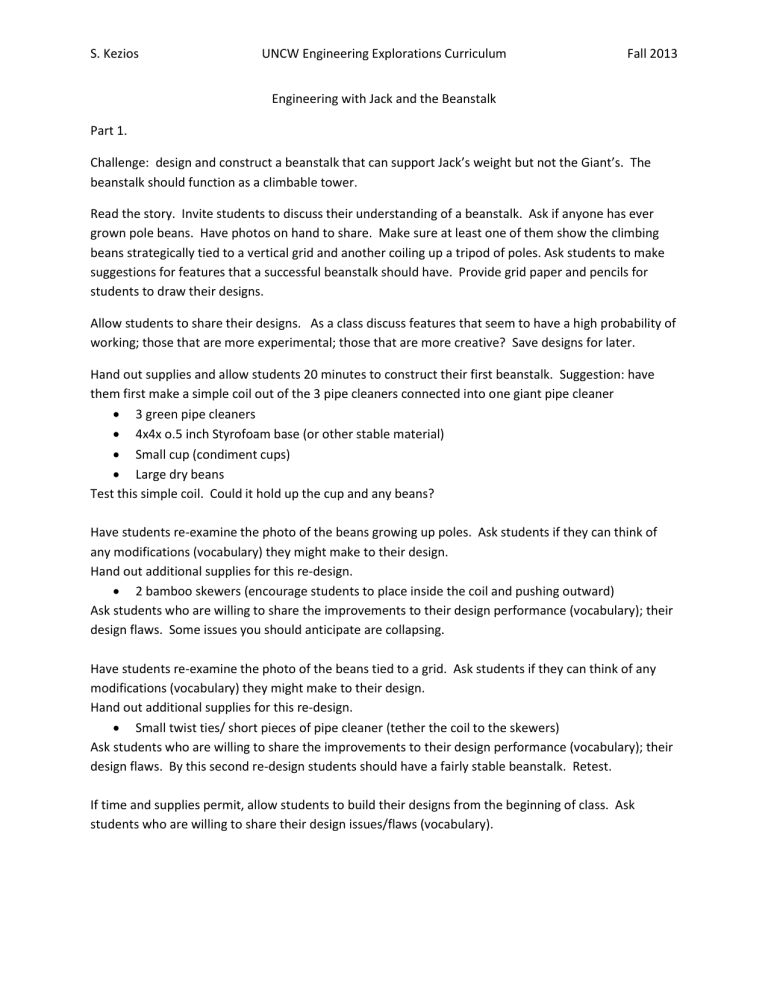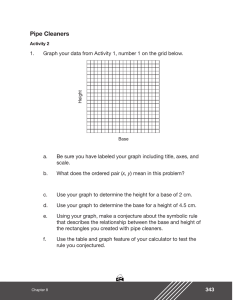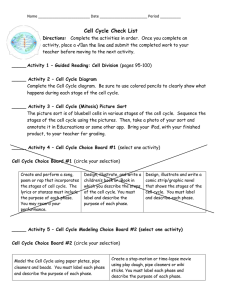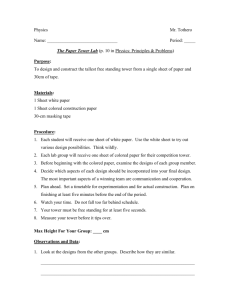S. Kezios UNCW Engineering Explorations Curriculum Fall 2013

S. Kezios UNCW Engineering Explorations Curriculum Fall 2013
Engineering with Jack and the Beanstalk
Part 1.
Challenge: design and construct a beanstalk that can support Jack’s weight but not the Giant’s. The beanstalk should function as a climbable tower.
Read the story. Invite students to discuss their understanding of a beanstalk. Ask if anyone has ever grown pole beans. Have photos on hand to share. Make sure at least one of them show the climbing beans strategically tied to a vertical grid and another coiling up a tripod of poles. Ask students to make suggestions for features that a successful beanstalk should have. Provide grid paper and pencils for students to draw their designs.
Allow students to share their designs. As a class discuss features that seem to have a high probability of working; those that are more experimental; those that are more creative? Save designs for later.
Hand out supplies and allow students 20 minutes to construct their first beanstalk. Suggestion: have them first make a simple coil out of the 3 pipe cleaners connected into one giant pipe cleaner
3 green pipe cleaners
4x4x o.5 inch Styrofoam base (or other stable material)
Small cup (condiment cups)
Large dry beans
Test this simple coil. Could it hold up the cup and any beans?
Have students re-examine the photo of the beans growing up poles. Ask students if they can think of any modifications (vocabulary) they might make to their design.
Hand out additional supplies for this re-design.
2 bamboo skewers (encourage students to place inside the coil and pushing outward)
Ask students who are willing to share the improvements to their design performance (vocabulary); their design flaws. Some issues you should anticipate are collapsing.
Have students re-examine the photo of the beans tied to a grid. Ask students if they can think of any modifications (vocabulary) they might make to their design.
Hand out additional supplies for this re-design.
Small twist ties/ short pieces of pipe cleaner (tether the coil to the skewers)
Ask students who are willing to share the improvements to their design performance (vocabulary); their design flaws. By this second re-design students should have a fairly stable beanstalk. Retest.
If time and supplies permit, allow students to build their designs from the beginning of class. Ask students who are willing to share their design issues/flaws (vocabulary).
S. Kezios UNCW Engineering Explorations Curriculum Fall 2013
Part 2.
Using a powerpoint presentation, invite students to observe some famous towers from around the country/world. Encourage students to identify features they have in common.
Assess the overall design of the more successful beanstalks. What components of these beanstalk designs can be translated (vocabulary) into a tower?
Foundation/anchor
Angled/curved sides
Floors/stabilizers
Using only 3 pipe cleaners, the teacher can demonstrate or have students build a three legged tower
[this should be a simple tripod]. Allow 5 minutes. How much weight can it support? Legs should splay outwards. Try with 4 pipe cleaners, same results. What does your design need to prevent this? The options are a foundation/anchor or stabilizers/tethers. Use pipe cleaners to create a simple foundation
(tie the base of the legs to each other) and retest. Tower should hold more beans but may buckle or twist. Create stabilizers by attaching pipe cleaners at different levels of the towers and retest.
Now, students should have all the experience and knowledge they need to build a tower on their own.
Hand out the design challenge supplies and allow students 20-30 minutes to engineer their tower.
Decide on criteria (example: must have 4 legs, 3 elevations/floors; must hold a certain number of beans or other weights).
Straws
Pipe cleaners
Styrofoam saucers
Popsicle sticks
Pressed foam sheet
Scissors and tape
Ask students who are willing to share their designs. What design flaws where detected? Should hear terms like bending, twisting, crushing. Ask what they did to correct – “how did they redesign” - for these flaws? Did their redesigns work?
Optional: you can add superlatives to the challenge to determine best designs. Examples would be tallest tower, tower that supports the most weight, most stable tower [think of some other tests you could do such as simulating an earthquake].
When everyone is finished, compare the strength of the different towers. What design principles seemed to work best.
Clean up!






